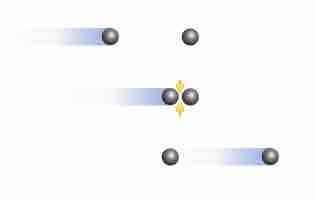The Ideal Gas Law is a convenient approximation for predicting the behavior of gases at low pressures and high temperatures. This equation assumes that gas molecules interact with their neighbors solely through perfectly elastic collisions, and that particles exert no intermolecular forces upon each other.

Elastic collisions between gas particles
Ideal gases are assumed to interact via perfectly elastic collisions in which no energy is lost.
Intermolecular forces describe the attraction and repulsion between particles. They include:
- Dipole-dipole forces
- Ion-dipole forces
- Dipole-induced dipole forces or Debye forces
- Instantaneous dipole-induced dipole forces or London dispersion forces.
The contribution of intermolecular forces creates deviations from ideal behavior at high pressures and low temperatures, and when the gas particles' weight becomes significant.
Intermolecular Forces and the Limitations of the Ideal Gas Law
- At low temperatures, gas particles have less kinetic energy, and therefore move more slowly; at slower speeds, they are much more likely to interact (attracting or repelling one another) upon collision. The Ideal Gas Law does not account for these interactions.
- At high pressures, gas particles are forced into close proximity with one another, causing significant intermolecular interactions.
- When the weight of individual gas molecules becomes significant, London dispersion forces, or instantaneous dipole forces, tend to increase, because as molecular weight increases, the number of electrons within each gas molecule tends to increase as well. More electrons means that when two gas molecules collide or converge, the electron clouds around each nucleus can repel one another, thereby creating an "instantaneous dipole" (a separation of charge resulting in a partial positive and partial negative charge across the molecule). The dipoles can then induce further dipoles in neighboring molecules, and the unlike charges between molecules can attract one another. At high pressures and low temperatures, these attractive forces can become significant.
Correcting for the Intermolecular Forces of Real Gases
To correct for intermolecular forces between gas particles, J.D. van der Waals introduced a new term into the Ideal Gas Equation in 1873. By adding the term n2a/V2 to pressure, van der Waals corrected for the slight reduction in pressure due to the interaction between gas particles:
In the term above, a is a constant specific to each gas and V is the volume. van der Waals also corrected the volume term by subtracting out the excluded volume of the gas. The full van der Waals equation of state is written as:
where b is the excluded volume of the gas, R is the universal gas constant, and T is the absolute temperature.